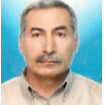International Journal of Modern Education and Computer Science (IJMECS)
IJMECS Vol. 13, No. 1, 8 Feb. 2021
Cover page and Table of Contents: PDF (size: 751KB)
Optimal Control of Model Reduction Binary Distillation Column
Full Text (PDF, 751KB), PP.59-68
Views: 0 Downloads: 0
Author(s)
Index Terms
Optimal control, Distillation column, Model Reduction, PID controller
Abstract
A binary distillation process with desired composition rate is considered. The aim is to find a control (Top and bottom compositions) which is optimal with respect to energy consumption and which is robust at the same time with respect to the response speed(less time) and minimum overshot. The solution approach is based on the formulation of two optimization techniques, Invasive Wood (IWO) and Differential Evolution (DE) with respect to Integral Square Error (ISE) and Integral Absolute Error (IAE) fitness function with using Proportinal_Integral-Derivative (PID) controller. An overall model including the dynamics of the distillation process is assumed with model reduction methods. This optimal control is compared with classical approach. The numerical results are presented and showed the effectiveness of the proposed control. MATLAB package is used for simulation and analysis.
Cite This Paper
Nasir Ahmed Alawad, Afaf Jebar Muter, "Optimal Control of Model Reduction Binary Distillation Column", International Journal of Modern Education and Computer Science(IJMECS), Vol.13, No.1, pp. 59-68, 2021.DOI: 10.5815/ijmecs.2021.01.05
Reference
[1] Gorak Andrzej, Schoenmakers Hartmut. Distillation: Operation and Applications. Academic Press; 2014.
[2] Skogestad Sigurd, Morari Manfred. Understanding the dynamic behavior of distillation columns. Ind. Eng. Chem. Res,vol. 27,no. 10,pp. 1848–1862,1988.
[3] Rein Luus,” Time Optimal Control of a Binary Distillation Column”, Dev Chem. Eng. Mineral Process, vol. lO,no. l/2, pp. 19-31,2002.
[4] Morari, M., Lee, J.H.,” Model predictive control: past, present and future”,Comput. Chem. Eng. Vol. 23,issues 4-5, pp. 667–682, May 1999.
[5] Betts John T. “Practical methods for optimal control and estimation using nonlinear programming”,. SIAM; 2010.
[6] Luus R. Iterative dynamic programming. Monographs and surveys in pure and applied mathematics. London, UK: Chapman,& Hall/CRC , 2000.
[7] Osuolale Funmilayo N, Zhang Jie. Energy efficiency optimisation for distillation column using artificial neural network models. Energy. vol.106, pp. 562–578, 2016.
[8] Karacan S, Hapoˇglu H, Alpbaz M.” Generalized predictive control to a packed distillation column for regulatory problems”.Computers & Chemical Engineering. vol. 22, Supplement 1, pp. S629–S632, 5 March 1998.
[9] Angelica Orjuel, Olga Ramos,” PID Control for Distilled Product and Bottom Concentration in a Binary Distillation Column”, International Review of Mechanical Engineering (IREME), Vol 11, No 4 ,2017.
[10] Bisgaard Thomas, Skogestad Sigurd, Abildskov Jens, Huusom Jakob K.”Optimal operation and stabilising control of the concentric heat-integrated distillation column (HIDiC)”. Computers & Chemical Engineering. ,vol. 96, pp. 196–211,4 January 2017,.
[11] Fabro João Alberto, Arruda Lucia VR, Neves Flávio. “Startup of a distillation column using intelligent control techniques”.Computers & Chemical Engineering. vol. 30, no. 2, pp.309–320, 2005.
[12] Hori Eduardo Shigueo, Skogestad Sigurd, Al-Arfaj Muhammad A.” Self-optimizing control configurations for two-product distillation columns”. In: :590Institution of Chemical Engineers; 1999; pp. 590-599,2006.
[13] Akemi G´alvez and Andr´es Iglesias,” Binary Distillation Column Design Using Mathematica”, Computational Science — ICCS, vol. 2657,pp.848-857,2003.
[14] Jiann-Shiou Yang,” Optimization-Based PI/PID Control for a Binary Distillation Column”, 2005 American Control Conference June , pp. 3650 – 3655 ,2005.
[15] M.Sharmila , V.Mangaiyarkarasi,” Modeling and Control of Binary Distillation Column”, International Journal of Advanced Research in Electrical, Electronics and Instrumentation Engineering, Vol. 3, Special Issue 4, May 2014.
[16] Wood RK and Berry MW. ”Terminal composition control of binary distillation column”. Chem Eng Sci,vol. 28,no. 9, pp. 1707–1717, 1973.
[17] Luyben, W.L.,” Distillation decoupling”.,AIChE Journal,vol.16,no. 2,pp. 198-203,1970.
[18] Wang, Q. G., Huang, B., and Guo, X. ,”Auto-tuning of TITO decoupling controllers from step tests”, ISA Trans. 2000, vol.39,no.4, pp.407–418,2000.
[19] Lu Liu, Siyuan Tian, Dingyu Xue,et al.” A Review of Industrial MIMO Decoupling Control”, International Journal of Control, Automation and Systems vol.17,pp 1-9, 2019.
[20] Luyben,W.L.,” Distillation decoupling”.,AIChE Journal,vol.16,no. 2,pp. 198-203,1970.
[21] G.J. Silva , A. Datta , S.P. Bhattacharyya,” Controller design via Pade approximation can lead to instability”, Proceedings of the 40th IEEE Conference on Decision and Control ,IEEE, pp. 4733-4737 ,2002.
[22] Russell C. Eberhart,Yuhui Shi,” Comparison between Genetic Algorithms and Particle Swarm Optimization”, Conference: Evolutionary Programming VII, 7th International Conference, EP98, San Diego, CA, pp. 611-616,1989
[23] Sidhartha Panda,N. P. Patidar,” Evolutionary Techniques for Model Order Reduction of Large Scale Linear Systems”, International Journal of Applied Science, Engineering and Technology ,vol.5,No.1, 2009.
[24] Qibing Jin, QiWang and Liye Liu,” Design of decentralized proportional– integral–derivative controller based on decoupler matrix for two-input/twooutput process with active disturbance rejection structure”, Advances in Mechanical Engineering,vol.8,No.6,2016.
[25] Saša Lj. Prodanovi, Novak N. Nedi,et al.,” Modified approach to distillation column control”, Hem. ind. ,vol. 71, no. 3,pp. 183–193, 2017.
[26] Trias Andromeda, Azli Yahya , Syahrullail Samion,” Differential Evolution for optimization of PID gain in electrical discharge control system”, Transactions of the Canadian Society for Mechanical Engineering, Vol. 37, No. 3, 2013.
[27] Mehrabian, A. R., & Lucas, C. (2006).” A novel numerical optimization algorithm inspired from weed colonization”. Ecological Informatics, vol. 1,no.4,pp. 355–366,2016.
[28] MojganMisaghi,MahdiYaghoobi,”Improved invasive weed optimization algorithm (IWO) based on chaos theory for optimal design of PID controller”, Journal of Computational Design and EngineeringVol. 6, Issue 3, pp. 284-295, July 2019.
